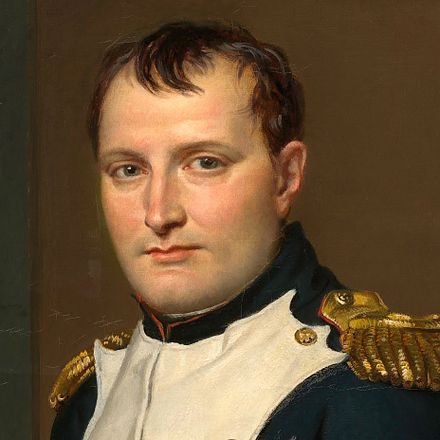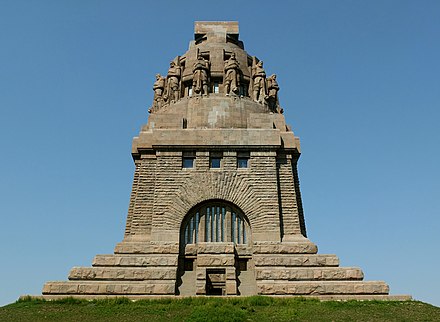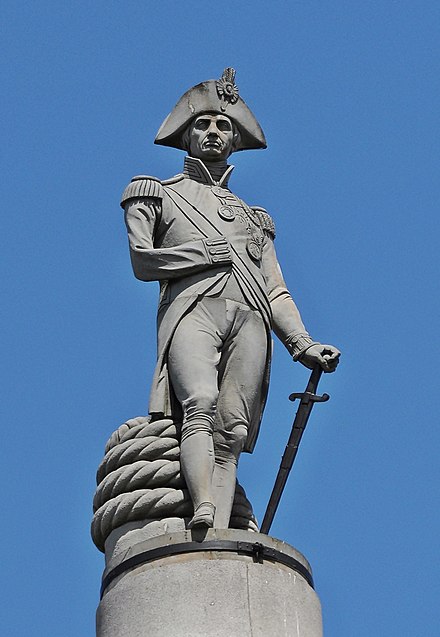See also: European history

 The Napoleonic Wars started as a preemptive war by Revolutionary France to forestall the attempt of the ancien régimes of Europe to suppress the French revolution, but soon became a war of conquest with the intention of "revolution export" by France. Although Napoleon was ultimately defeated, arguably his greatest legacy was secularism (the separation of church and state), which forms the basis of governance in most European countries to this day. The French flavour of secularism, laïcité, remains an integral part of French national identity today.
The Napoleonic Wars started as a preemptive war by Revolutionary France to forestall the attempt of the ancien régimes of Europe to suppress the French revolution, but soon became a war of conquest with the intention of "revolution export" by France. Although Napoleon was ultimately defeated, arguably his greatest legacy was secularism (the separation of church and state), which forms the basis of governance in most European countries to this day. The French flavour of secularism, laïcité, remains an integral part of French national identity today.
Understand
During early modern times, the Kingdom of France had gained a role as Europe's superpower. The French Revolution, beginning in 1789, led to fifteen years of short-lived, often brutal, governments. In the French Revolutionary Wars, the French Army defeated the other great powers; the United Kingdom, Prussia, Austria, and the Holy Roman Empire.
Soon the revolutionary government was taken over by a young charismatic general from Corsica of the name of Napoleone Buonaparte (now known as Napoleon I or Bonaparte) and he crowned himself emperor of the French in 1804. The Emperor title was traditionally a claim to succeed the Roman Empire; since the 9th century AD, the Holy Roman Empire had been a feudal political entity in Central Europe, which by Napoleon's time had become largely ceremonial, and dominated by the Austrian monarchy. In 1806, the last Holy Roman Emperor Francis II abdicated the title, over concern that Napoleon would claim it.
Despite his army conquering much of Europe, his navy lost the decisive Battle of Trafalgar in 1805, and never managed to dislodge the British from their position as the world's dominant naval power. Unable to invade the British mainland, the French tried to support an Irish rebellion to weaken the British Empire but that rebellion ended in disaster. After almost three decades of next to constant warfare in ever-shifting alliance that brought most of the continent much needed political reform but also "Napoleonic" puppet governments, Napoleon attempted an ill-fated invasion of Russia in 1812 that led to his decisive defeat first near Leipzig and after escaping from exile on Elba near Waterloo in 1815. The war was also global in a sense, as both the War of 1812 in North America and the Haiti revolution can only be understood with the context of the French revolutions and the Napoleonic wars. The wars are sometimes known as "Coalition Wars" as the ever shifting alliances gave rise to a periodization along the lines of War of the First Coalition, War of the Second Coalition and so on.
Legacy
Napoleon's invasion of Spain led to the forced abdication of two Spanish monarchs and the installment of one of his brothers as king, which in turn galvanized a nascent movement for independence led by the likes of Simon Bolivar, José de San Martin and others ultimately resulting in all of mainland Latin America slipping away from Spanish control. The Portuguese royal family relocated to Brazil, causing that country to eventually declare independence from the mother country as the Empire of Brazil while ruled by a different branch of the same royal/imperial family. On his way through Europe, Napoleon smashed the Holy Roman Empire and ended the independence of the Republic of Venice, he ended centuries of feudal privilege and obligation and spread Jewish emancipation as well as Civil Law that treated everybody (mostly) equally. The Code Napoleon is still the basis for law in Louisiana and (via the German BGB) Japan as well as numerous other countries (see history of justice). Resistance against Napoleon soon made use of the "levee en masse" tactic of revolutionary France and galvanized for the first time a sense of nationalism. The Napoleonic Wars in a sense laid the groundwork for both the (bourgeois-nationalistic) revolutions of 1848 and the post World War I world with nation states emerging out of the ashes of multinational empires like the Russian Empire or Austria-Hungary.
The image and perception of Napoleon and his adversaries have undergone and continue to undergo reappraisals over the centuries. In Poland Napoleon is often regarded as a hero, and even mentioned in the national anthem, whereas many in Tyrol idolize the anti-Napoleon fighter Andreas Hofer despite his often anti-science, anti-civil rights and downright reactionary stances. Napoleon sold the Louisiana purchase to the United States, giving them huge territories which were charted by the Lewis and Clark expedition and became the Old West, where the expansion of slavery led up to the American Civil War; he elevated Saxony and Bavaria to kingdoms, giving the latter the territory of Franconia to the enduring chagrin of locals two hundred years later. The desire to emulate his uncle led Napoleon III of France into ill-advised military adventures in Italy (helping that country to become unified under Victor Emanuel II, the first "King of Italy" since Napoleon I), Mexico (giving us "Cinco de Mayo") and against Prussia, leading to the loss of Alsace which would be one of the main gripes driving France to hostility towards Germany and into World War I.
Sites
Austria
- Vienna, 48.208°, 16.373°. The Emperor of Austria was one of Napoleon's arch-enemies, and eventually defeated his armies. After the war, the 1814–1815 Congress of Vienna set the new European borders. Artifacts from the Napoleonic wars are displayed in the Museum of Military History (Heeresgeschichtliches Museum).
Belarus
- Barysaŭ, 54.3258°, 28.3605°. Site of the Battle of Berezina during the French retreat from Russia. The French and their allies suffered massive casualties during the crossing of the river. Bérézina has entered French common parlance as a synonym for "disaster". The battle is sometimes reenacted during local festivals. 2019-12-31
Belgium
- Waterloo, 50.7167°, 4.3833°. Where Napoleon was finally defeated, now a universal symbol for defeat, not least due to the ABBA song.
Czech Republic
- Slavkov u Brna, 49.1548°, 16.8742°. Site of the Battle of Austerlitz, a decisive French victory over Austria in 1805. An armistice between France and Austria was signed at the Baroque Slavkov Castle.
France
 Napoleon himself is buried in Paris/7th arrondissement in the Dôme des Invalides. There is a great Army Museum (Musée de l'Armée) next door that was founded in 1795 and expanded by Napoleon, but the current building dates from 1905. The Vendôme Column 📍, centerpiece of Place Vendôme, raised to commemorate the victory at Austerlitz, La Madeleine church 📍, originally commissioned as the Temple de la Gloire de la Grande Armée ("Temple to the Glory of the Great Army"), and the Arc de Triomphe 📍 are very significant monuments in this context, and should not be missed.
Napoleon himself is buried in Paris/7th arrondissement in the Dôme des Invalides. There is a great Army Museum (Musée de l'Armée) next door that was founded in 1795 and expanded by Napoleon, but the current building dates from 1905. The Vendôme Column 📍, centerpiece of Place Vendôme, raised to commemorate the victory at Austerlitz, La Madeleine church 📍, originally commissioned as the Temple de la Gloire de la Grande Armée ("Temple to the Glory of the Great Army"), and the Arc de Triomphe 📍 are very significant monuments in this context, and should not be missed.
- Hôtel des Invalides, 6, boul des Invalides (
Invalides), 48.85595°, 2.31270°. Founded in 1671 by Louis XIV as a hospital for 6,000 wounded soldiers—this function explaining the name of the building—the golden-domed Hôtel des Invalides still functions as an infirmary and now also houses the Musée de l'Armée. The church attached, l'Eglise du Dôme, houses the tomb of Napoleon.
- Napoleon's house, Ajaccio, 41.9179562°, 8.7387456°. Napoleon was famously born on Corsica (though the claim that he was born before France took control of the island is the same British propaganda that also caused the persistent rumor of him being unusually short). His home from birth has been turned into a museum
- Palace of Fontainebleau (Château de Fontainebleau). Houses a Napoleon museum. 2022-02-15
Germany

-
There is a rather bombastic Monument of the Battle of Nations 📍 (Völkerschlachtdenkmal in German) in Leipzig. Standing 91 metres tall, it is the biggest monument in Europe. It was erected in time for the first centennial (1913). Despite the nationalistic spirit prevalent at that time (one year before the beginning of World War I), the monument does not glorify war, but laments the lives lost: The giant soldier statues have a sad and weary expression rather than a heroic one, and the water pond in front of the monument is called "lake of tears". Adepts will find numerous Masonic symbols as the architect was a Freemason.
-
The Quadriga statue on top of the Brandenburg Gate in Berlin 📍, designed as a symbol of peace, was taken to Paris by Napoleon as war loot after conquering Prussia in 1806. It was returned to Berlin after Napoleon's defeat in 1814, which is the reason for its Berolinian nickname Retourkutsche (literally "return carriage" but figuratively meaning "retort"). The Iron Cross, decoration awarded of the German freedom fighters, and the Prussian Eagle were added to the Victoria figure, making the ensemble a monument to the victory over Napoleon. The National Monument for the Liberation Wars on the Kreuzberg hill in Berlin, designed by Karl Friedrich Schinkel, is another Prussian memorial to this series of wars.
-
There is a 46-metre high Waterloo column in Hanover, erected in 1825–1832 to commemorate the Allied victory over Napoleon. Hanover was ruled in personal union by the British monarchs until its occupation by the French army in 1803, leading to its annexation to the French puppet state "Kingdom of Westphalia". In 1814, the Kingdom of Hanover was restored, again ruled by the British monarchs until 1837. Thus, troops from Hanover fought in Wellington's army.
-
Napoleon memorial stone near Jena 📍 at the site of the Battle of Jena–Auerstedt in 1806, a decisive French victory over Prussia. Military-historical reenactments take place at the site from time to time.
-
The Hall of Liberation in Kelheim near Regensburg was dedicated by Bavarian king Ludwig I to commemorate the victory of German freedom fighters against Napoleon.
-
Pfalzgrafenstein Castle near Kaub sits picturesquely on an islet in the middle of the Rhine. This is the place where the Prussian army under Blücher with 60,000 men and 20,000 horses crossed the river in January 1814 during their pursuit of Napoleon's retreating army. From there, they started the reconquest of German territories west of the Rhine that had been part of the French Empire for nearly 20 years. There is also a monument and museum dedicated to Blücher.
-
In 1793, the short-lived Republic of Mainz was a "sister republic" of revolutionary France and the first republic in Germany. It was later annexed by France. The Deutschhaus, former commandry of the Teutonic Knights, was the seat of parliament of the Mainz Republic, later served as a residence of Napoleon, and is now the parliament of the state of Rhineland-Palatinate.
Great Britain

- Trafalgar Square 📍 is named for the naval Battle of Trafalgar off the coast of Spain. Its main landmark is the 169-ft (52 m) Nelson's Column, atop which the admiral looks down Whitehall towards the Palace of Westminster.
- On Hyde Park Corner 📍 stands the London residence of the Dukes of Wellington, part of which has been converted into a museum of the 1st duke's life, who is also commemorated on the Corner by a statue and a neoclassical arch.
- St Paul's Cathedral 📍, London's main Anglican cathedral, is the burial site of Nelson and Wellington.
South west of the capital, the county of Hampshire has several connections to the Wars and its players:
- The Historic Dockyards 📍 in Portsmouth keep a number of the Royal Navy's famous old vessels, including Nelson's command ship HMS Victory, where you can visit the spot he died.
- Portchester Castle 📍, north of Portsmouth, is best known as a Roman and Medieval castle, but was later used as a gaol for more than 7,000 French prisoners of war.
- Stratfield Saye House 📍, on the road between Basingstoke (8 mi) and Reading (10 mi), is the Wellingtons' country pad, where you can get a guided tour of the stately home and a small museum, before exploring the estate by yourself and visiting Copenhagen's grave.
- The country's largest monument to the Iron Duke, an Equestrian Statue of the Duke of Wellington 📍, was originally unveiled at Hyde Park Corner, but was widely disliked for its ostentatious size and was moved out of the capital to the garrison town of Aldershot once the duke was safely dead.
Italy
- Elba, 42.7618°, 10.2408°. Napoleon was exiled here in 1814, but escaped to take power in France once more after the first Bourbon Restoration ran into problems with its low popularity and the former enemies of France seemed to be letting their guard down
Portugal
- Linhas de Torres Vedras (Lines of Torres Vedras). A chain of 152 forts and other defenses built north of Lisbon to defend the capital from Napoleon's armies. 2021-08-25
Russia
- Borodino battlefield and museum, Mozhaysk district (30 km northwest of Vereya), 55.5208°, 35.8208°. Site of the Battle of Borodino during Napoleon's invasion of Russia in 1812, resulting in some 70,000 dead soldiers on both sides and Napoleon's temporary capture of Moscow.
Slovakia
One of the several peace treaties during the Napoleonic Wars was signed in Bratislava which is still commemorated at the site of its signing.
Spain
- Cabo de Trafalgar. Cape which lends its name to the famed Battle of Trafalgar in 1805, the saw the British navy score a decisive victory against the combined French and Spanish navies, thus scuttling Napoleon's plans to dominate the seas, and cementing the United Kingdom's place as the world's dominant naval power for the rest of the 19th century, and much of the first half of the 20th century up to World War II.
- Museo Naval de Madrid (Naval Museum of Madrid), Paseo del Prado, 5 (), 40.41755°, -3.69273°, +34 915 238 516, ohculturanaval@fn.mde.es. Sep- Jul: Tu-Su 10:00-19:00; Aug: Tu-Su 10:00-15:00. An excellent museum featuring the Battle of Trafalgar. €3 (requested donation) 2017-01-27
South Atlantic
Napoleon was famously banished to Saint Helena after Elba proved too close to mainland Europe. Rumors of his poisoning by the British are long-lived though probably unjustified.
- Longwood House. Site of Napoleon's final exile and a museum. 2022-02-15
United States
The Star-Spangled Banner National Historic Trail commemorates the Chesapeake Campaign.